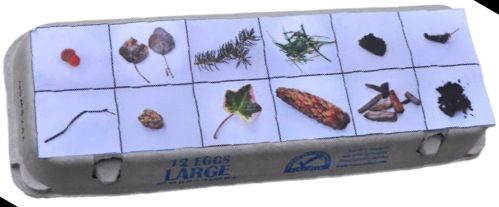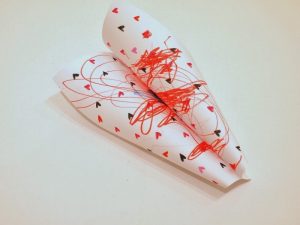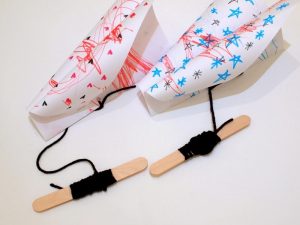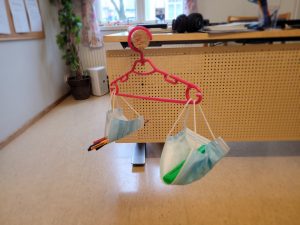- Cut clouds, sun and raindrops from felt fabric.
- Glue them on a fabric bag with textile glue.
- Paint different weather symbols on the stones and put them in the bag.
- Let the children pick a stone from the bag and come up with a story from the picture on the stone; for example, about a sunny day or a snowfall. What is the weather like? What is being put on? Are there any animals outside?
Väderstenar
Väderstenar
- Klipp moln, sol och regndroppar från filt-tyg.
- Limma dem på en tygpåse med textillim.
- Måla olika vädersymboler på stenar och lägg dem i påsen.
- Låt barnen plocka en sten från påsen och komma med en berättelse från bilden på stenen; om exempelvis en solig dag eller ett snöfall. Hur är vädret? Vad sätts på? Finns det några djur ute?
Tack lekolar.fi för tipset.
Scavage hunt with egg carton
A small idea for when you go on an excursion.
Take an empty egg carton with task cards stuck on top. Then let them add in what the card shows. It could be putting in the same things, the same number, colour, shape, or maybe even something that starts with the same letter.
Skattjakt med äggkartong
Ett enkelt tips när du går ut på utflykt. Ge varje barn, eller grupp av barn, en äggkartong med påklistrade uppgiftskort ovanpå. Låt dem sedan lägga i efter vad kortet visar. Det kan vara att lägga i samma saker, samma antal, färg, form, eller kanske rent av något som börjar på samma bokstav.

Make Your Own Kite
Materials to Make a Simple Paper Kite:
- Printer paper
- Scissors
- Yarn (This worked ok with me, but I wish I used a lighter string.)
- Tape
- Popsicle Stick
- Markers
- Hole Puncher
- Stapler
- Ruler
Directions to Make a Simple Paper Kite:
- Draw a design on both sides of your paper. (Chuck and I did this collaboratively.)
2. Fold your paper in half. (Half the length.)
3. Using your ruler, make a mark at 2 1/2 ” and a mark at 3 1/2″ on the folded edge.
4. Now curve both corners of your paper down and staple them at the 2 1/2″ mark. (Don’t fold them down, make sure the paper is curved.) Your kite should now look like this.

- Punch at hole at the 3 1/2″ mark. Then, cut a long piece of string and tie it to your kite.
6. Tape the other end of your string down to a popsicle stick. Wind your excess string around the Popsicle stick so it doesn’t get tangled.
Now go fly your own kite! It takes a strong gust of wind to lift your kite, but if you run around (or ride your bicycle really fast), your kite will float along beside you too.

Gör en egen pappersdrake
Material:
- Skrivpapper
- Sax
- Garn (Detta fungerade bra för mig, men jag önskar att jag hade använt ett lättare snöre.)
- Tejp
- Glasspinne
- Tuschpennor
- Hålslag
- Häftapparat
- Linjal
Instruktioner
- Rita ett mönster på båda sidor av pappret.
- Vik pappret på mitten. (Halva längden.)
- Med hjälp av din linjal gör du ett märke vid 6,5 cm och ett märke vid 9 cm på den vikta kanten.
- Böj nu båda hörnen på ditt papper nedåt och häfta ihop dem vid 6,5 cm märket. (Vik inte ner dem, se till att pappret är böjt.) Din drake ska nu se ut så här.

- Stansa ett hål vid 9 cm markeringen. Klipp sedan en lång bit snöre och knyt den till din drake.
- Tejpa fast den andra änden av ditt snöre på en glasspinne. Linda ditt överflödiga snöre runt glasspinnen så att det inte trasslar ihop sig.
Nu kan du gå ut och flyga med din egengjorda drake! Det krävs en kraftig vindpust för att lyfta din drake, men om du springer runt (eller cyklar riktigt fort) kommer din drake också att flyta bredvid dig.

Build your own balance scale
Explore together concepts such as heavy and light, or heavier and lighter, using (unused) face masks.
Ok. You’ll need a clothes hanger too. And the face masks can be replaced with two equal-sized cans with handles if you want.
Hang one face mask on each end of the hanger. Be careful that they hang the same distance from the middle to get an accurate scale.
 Then you can start compare different things. You can start by letting the children feel each hand and guess which one is heavier. First perhaps with things that have a little more difference, a raisin and an apple then you can try things closer together.
Then you can start compare different things. You can start by letting the children feel each hand and guess which one is heavier. First perhaps with things that have a little more difference, a raisin and an apple then you can try things closer together.
For a bigger challenge, swap the clothes hanger for a stick and work together to get the empty scale balanced first.
Bygg din egen balansvåg
Undersök tillsammans begrepp som tung och lätt, eller tyngre och lättare med hjälp av (oanvända) munskydd.
Ok. Du behöver en klädhängare också. Och munskydden går att byta ut mot två lika stora burkar med handtag om man så vill.
Häng ett munskydd i vardera änden på klädhängaren. Var noggrann att de hänger på samma avstånd från mitten för att få en rättvisande våg.

Sedan kan du jämföra olika saker. Börja gärna med att låta barnen känna i vardera handen och gissa vilken som är tyngst. Först kanske med saker som har lite större skillnad, ett russin och ett äpple sedan kan man pröva saker närmre varandra.
För en större utmaning, byt ut klädhängaren mot en pinne och arbeta tillsammans med att få den tomma vågen i jämnvikt först.
Färgrpromenad
Ta en promenad utomhus och observera vad ni ser runt omkring er. Leta efter saker i de olika färgerna. Rita av varje sak ni hittar i rätt ruta.
Om ni vill ha ett färdigt Färgpromenad (pdf, 28 kB)-papper.
Ett tips från Buggy and Buddy
Skräplabbet
Håll Sverige Rent har många tips för att utnyttja skräp i skolarbetet, för såväl förskola som uppåt i åldrarna.
Skräplabbet hittas på https://skraplabbet.se/teacher
